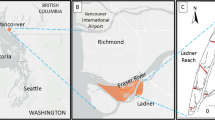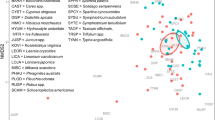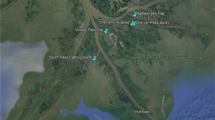Abstract
We document the regeneration of native freshwater wetland plant assemblages following removal of the common reed, Phragmites australis (Cav.) Trin. ex Steudel from two sites at Chapman Pond, East Haddam, Connecticut, USA. We gathered field data on composition of the vegetation 1 year before and for each of the 3 years after the removal in fall 1995/spring 1996 of Phragmites by two slightly different methods (hand-removal and herbiciding in one area, mowing/mulching and herbiciding in another). An area where Phragmites was left intact was similarly monitored. Our goals for this monitoring were: (1) to document plant species composition and richness before and after Phragmites removal and (2) to examine temporal and spatial variability in patterns of plant recruitment. Phragmites declined in both density and extent in both plots where removal treatments were applied. Richness, evenness, and density of non-Phragmites species increased steadily from 1996 to 1997 in all removal and intact plots. However, the species composition of the removal plots was richer than that of the intact plot, and more closely resembled that of comparable, uninvaded freshwater tidal wetlands. Rates of recovery of species richness in the removal plots declined from 1997 to 1998, potentially reflecting saturation of available colonization space, or the return of Phragmites. Phragmites has expanded its range in both of the removal plots since 1997. A model of its colonization indicates that Phragmites occupies space through localized proliferation of dense rhizomes rather than diffusely foraging with long tillers. Vigilance in monitoring is needed to document the spread of invasives, to evaluate the multi-faceted ecological effects of eradication efforts on both the invader and the regenerating community, and develop strategies for preventing re-invasion.
Similar content being viewed by others
References
Barrett NE (1994) Vegetation patch dynamics in freshwater tidal wetlands. PhD dissertation, University of Connecticut, Storrs, Connecticut, 253 pp
Bibby CJ and Lunn J (1982) Conservation of reed beds and the avifauna in England and Wales. Biological Conservation 23: 167–187
Boar RR, Crook CE and Moss B (1989) Regression of Phragmites australis reedswamps and recent changes of water chemistry in the Norfolk Broadland, England. Aquatic Botany 35: 41–55.
Bongiorno SF, Trautman JR, Steinke TJ, Kawa-Raymond S and Warner D (1984) A study of restoration in Pine Creek salt marsh, Fairfield, Connecticut. In: Webb FJ (ed) Proceedings of the 11th Annual Conference on Wetlands Restoration and Creation, pp 10–19. Hillsborough Community College, Tampa, Florida
Boone J, Furbish E and Turner K (1987) Control of Phragmites communis: results of burning, cutting and covering with plastic in a North Carolina salt marsh. National Park Service, Cooperative Park Studies Unit, Athens, Georgia
Chambers RM, Meyerson LA and K Saltonstall (1999) Expansion of Phragmites australis into tidal wetlands of North America. Aquatic Botany 64: 261–273
Cowie NR, Sutherland WJ, Ditlhogo MKM and James R (1992) The effects of conservation management of reed beds, II. The flora and litter disappearance. Journal of Applied Ecology 29: 277–284
Ditlhogo MKM, James R, Laurence BR and Sutherland WJ (1992) The effects of conservation management of reed beds, I. The invertebrates. Journal of Applied Ecology 29: 265–276
Gleason HA and Cronquist A (1991) Manual of vascular plants of northeastern United States and adjacent Canada. New York Botanical Garden, Bronx, New York
Hara T, van der Toorn J and Mook JH (1993) Growth dynamics and size structure of shoots of Phragmites australis, a clonal plant. Journal of Ecology 81: 47–60
Hartog CD, Kvet J and Sukopp H (1989) Reed: a common species in decline. Aquatic Botany 35: 1–4.
Haslam SM (1971) Community regulation in Phragmites communis Trin. I. Monodominant stands. Journal of Ecology 59: 65–73.
Hastings A (1996) Models of spatial spread: a synthesis. Biological Conservation 78: 143–148.
Hurlbert SH (1984) Pseudoreplication and the design of ecological field experiments. Ecological Monographs 54: 187–211
Lovett-Doust, L (1981) Population dynamics and local specialization in a clonal perennial (Ranunculus repens). I. The dynamics of ramets in contrasting habitats. Journal of Ecology 69: 757–768
Marks M, Lapin B and Randall J (1994) Phragmites australis (P. communis): threats, management, and monitoring. Natural Areas Journal 14: 285–294
Meyerson LA, Saltonstall K, Windham L, Kiviat E and Findlay S (in press) A comparison of Phragmites australis in freshwater and brackish marsh environments in North America. Wetlands Ecology and Management
Niering WA, Warren RS and Weymouth, C (1977) Our dynamic tidal marshes: vegetation changes as revealed by peat analysis. Connecticut College Arboretum Bulletin No. 22, New London, Connecticut
Orson R, Warren RS and Niering WA (1987) Development of a southern New England drowned valley tidal marsh. Estuaries 10: 6–27
Ostendorp W (1989) ‘Die-back’ of reeds in Europe: a critical review of literature. Aquatic Botany 35: 5–26
Prisloe, S and Barrett N (1998) Spatial patterns of expansion by Phragmites australis (Cav.) Trin. ex Steud. within the tidelands of the Connecticut River from 1968 to 1994. CD-ROM and report to The Nature Conservancy, Middletown, Connecticut
Randall J and Lapin B (1995) The Nature Conservancy Element Stewardship Abstract: Phragmites australis. The Nature Conservancy, Arlington, Virginia
Stalter R and Baden J (1994) A twenty-year comparison of three abandoned rice fields, Georgetown County, South Carolina. Castanea 59: 69–77
van der Valk AG and Pederson RL (1989) Seed banks and the management and restoration of natural vegetation. In: Leck MA, Parker VT and Simpson RL (eds) Ecology of soil seed banks, pp 329–346. Academic Press, San Diego, California
Windham L (1995) Effects of Phragmites australis invasion on aboveground biomass and soil properties in brackish tidal marshes of the Mullica River, New Jersey. MSc thesis, Rutgers University, New Brunswick, New Jersey
Author information
Authors and Affiliations
Corresponding author
Rights and permissions
About this article
Cite this article
Farnsworth, E.J., Meyerson, L.A. Species Composition and Inter-annual Dynamics of a Freshwater Tidal Plant Community Following Removal of the Invasive Grass, Phragmites australis. Biological Invasions 1, 115–127 (1999). https://doi.org/10.1023/A:1010068607630
Issue Date:
DOI: https://doi.org/10.1023/A:1010068607630




